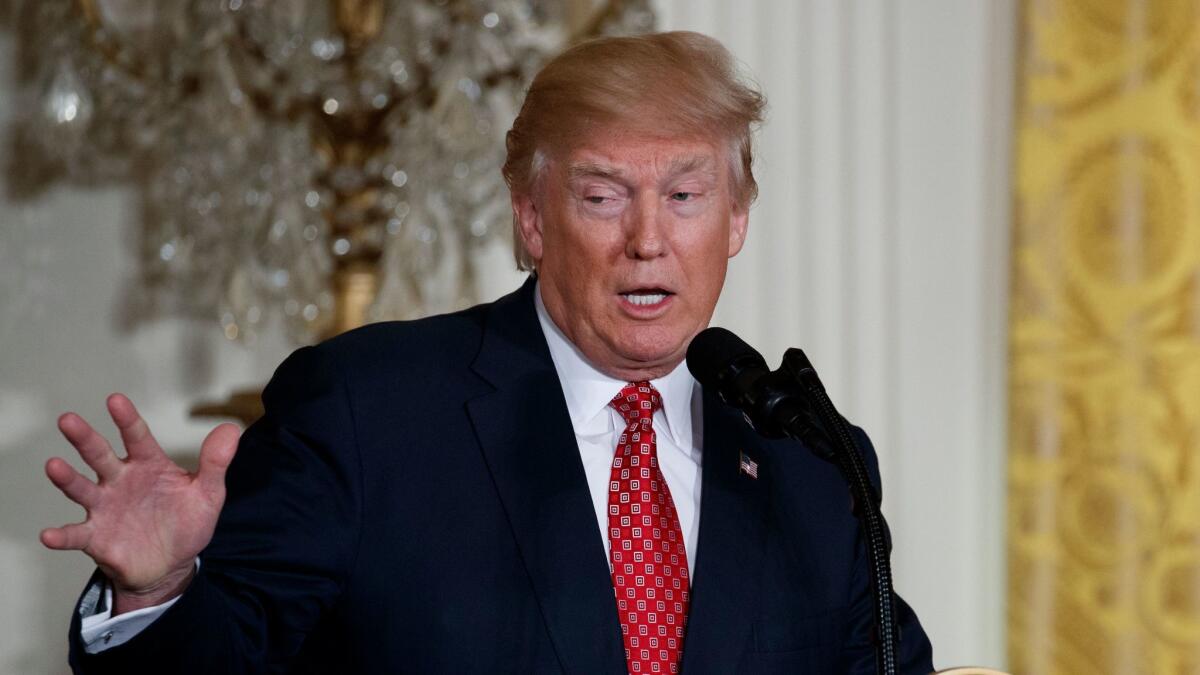Trump says he’s considering a new, narrower travel ban

Reporting from Washington — Rebuffed again by the courts, President Trump said Friday that he is weighing a new, more narrowly tailored executive order to curb entry into the U.S., a step that would mean setting aside his legal battle in favor of moving more quickly on his broader goal of restricting the flow of who comes into the country.
“We need speed for reasons of security,” the president told reporters as he traveled to Florida on Friday.
Trump said he might implement a “brand-new order” as early as next week. That step could effectively void his first executive order and end the court proceedings over it.
Trump insisted that he was confident his policy was on solid legal ground, a day after judges on the 9th U.S. Circuit Court of Appeals unanimously refused to reinstate his temporary bans on travelers from seven majority-Muslim countries and on all refugees. But he suggested that he was uninterested in a prolonged fight in court.
“We will win that battle,” Trump said. “The unfortunate part is that it takes time.”
The administration was considering several options, Chief of Staff Reince Priebus said late Friday at the White House, including asking the Supreme Court to lift the temporary restraining order on the travel bans that the 9th Circuit panel kept in place.
The new order under consideration would suspend only refugee admissions and the issuance of new visas, according to an administration official familiar with the internal deliberations. Everyone who already was granted a visa or refugee status would be allowed to keep them.
The new directive would be intended to allay the type of chaos that erupted as a result of Trump’s Jan. 27 order, which blocked an estimated 60,000 people with valid visas, some while they were in midair and others who were removed from planes bound for the U.S. before takeoff. The federal court rulings against Trump cited the rough implementation of the order in staying it.
In addition to temporary bans on entry by refugees and on all citizens of Iran, Iraq, Libya, Somalia, Sudan, Syria and Yemen, the order Trump issued also indefinitely suspended the admission of Syrian refugees and gave preference to refugees who are members of persecuted religious minorities.
“We will not allow people into our country who are looking to do harm to our people. We will allow lots of people into our country that will love our people and do good for our country,” Trump said earlier Friday at a White House news conference alongside Japanese Prime Minister Shinzo Abe.
If Trump does decide to fight the restraining order all the way to the Supreme Court, he may undercut his objectives, legal experts warn, particularly given the court’s 4-4 split between Republican and Democratic appointees.
A tie is possible, similar to the stalemate last year over President Obama’s immigration order temporarily protecting millions in the country illegally from deportation. If the Trump administration can’t win five votes, the 9th Circuit order would remain in effect.
“The government needs to take its medicine and withdraw the current executive order, substituting with one that clearly exempts [green card holders] and previously admitted nonimmigrant visa holders like students and medical residents. Otherwise, the government is in a box,” said Peter Margulies, who teaches immigration law at Roger Williams Law School in Rhode Island.
If the government appeals to the Supreme Court, Justice Anthony Kennedy would receive the request and probably ask for written briefs in the coming days.
The court’s conservative justices would be likely to see merit in the government’s claim that the law calls for deferring to the president on matters of immigration and national security.
The liberal justices would be likely to agree with the two states that sued the administration, Washington and Minnesota, that Trump’s order was rash, disruptive and unfair to foreign travelers who were traveling legally into and out of the country.
If the White House chooses to fight on, justices could take action that would effectively yield the same outcome as Trump rescinding the order, with a a middle-ground ruling rather than an all-or-nothing decision.
The court could allow the ban to apply to thousands of foreigners who have obtained U.S. visas but have not yet used them, but not to green card holders, foreign students, doctors, technology company executives and tourists who were already living in the U.S. when the travel restrictions were announced.
Such a move could allow the high court to avoid a tie and a broader debate on the constitutionality of the ban.
Some immigration lawyers say a middle-ground ruling makes sense legally and practically.
“This would provide a balanced remedy that would relieve the chaos,” Margulies said. “It would protect the visa holders who are here and want to travel outside the country. It’s unfair to change the rules on them. But it would not apply to people who have never been admitted to this country.”
“I think it’s possible Justices [Stephen G.] Breyer or [Elena] Kagan might think a modified restraining order makes more sense,” he said.
Temple University law professor Peter Spiro agreed that if the case reached the high court, the justices might move toward narrowing the order, noting that U.S. law gives more protection to people who are in this country, even if they were foreign citizens.
“The courts have been generally deferential to the political branches when it comes to immigration, but they have been less deferential when it comes to noncitizens already present in the U.S.,” he said. “So this makes sense, both politically and legally….
“From the administration’s perspective, a limited reinstatement would get them much of what it’s looking for: No new visas would be issued to nationals of the listed countries or to refugees.”
Justice Department attorney August Flentje advocated for such an approach in the final minutes of his argument Tuesday before the appeals court panel. He called the temporary restraining order against the ban “vastly over-broad.”
But in its decision Thursday night, the three judges said courts were ill-equipped to make such distinctions.
“Even if the [temporary restraining order] might be over-broad in some respects, it is not our role to try, in effect, to rewrite the executive order,’’ the panel ruled.
Twitter: @mikememoli
Twitter: @bybrianbennett
Twitter: @davidgsavage
ALSO:
Supreme Court may look for a middle ground on Trump’s travel ban by shielding only certain travelers
6 times when presidents besides Trump weighed in on court rulings
UPDATES:
3:55 p.m.: This story was updated with Trump saying he’s considering a new travel ban.
This story was originally published at 12:05 p.m.
More to Read
Get the L.A. Times Politics newsletter
Deeply reported insights into legislation, politics and policy from Sacramento, Washington and beyond. In your inbox three times per week.
You may occasionally receive promotional content from the Los Angeles Times.













